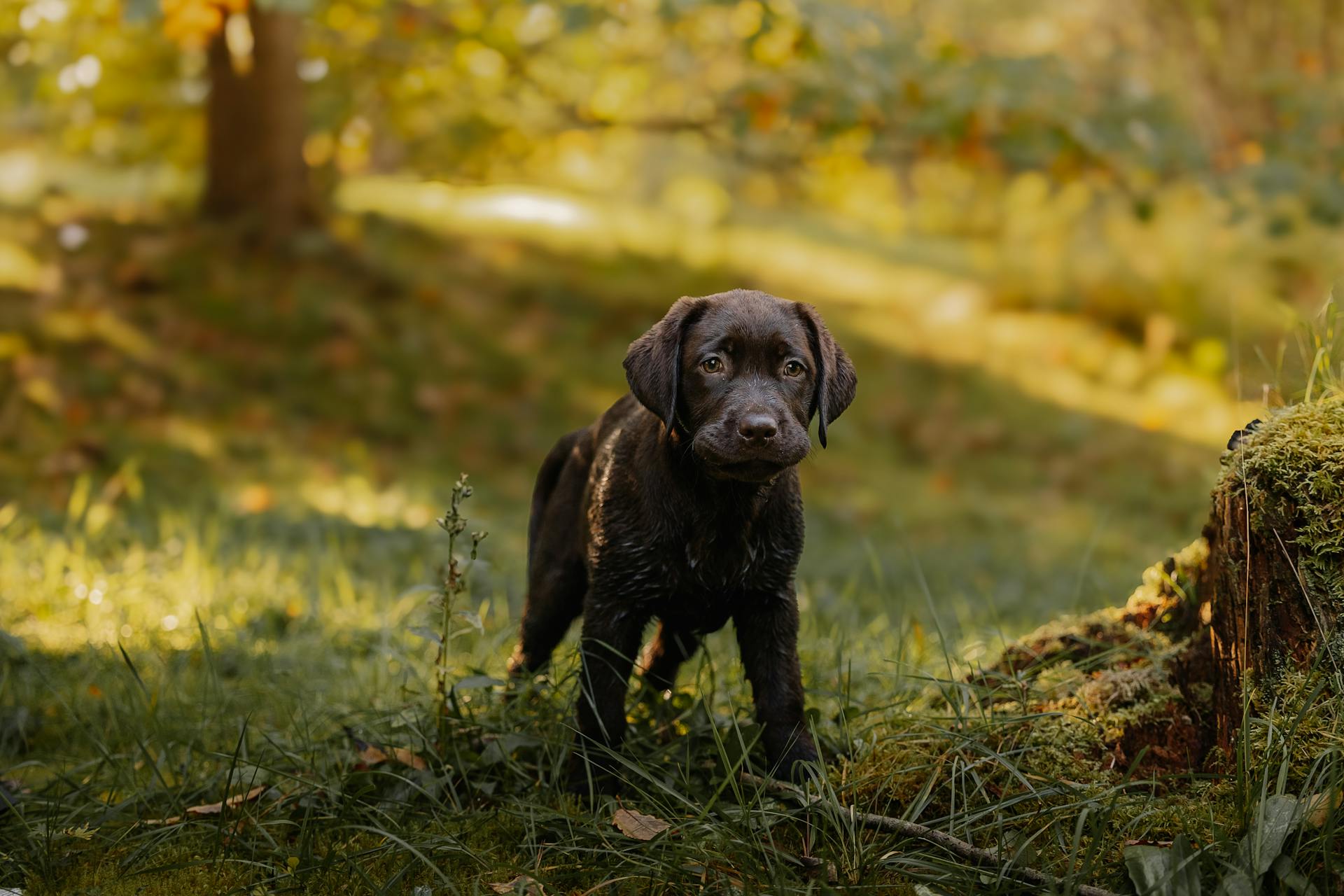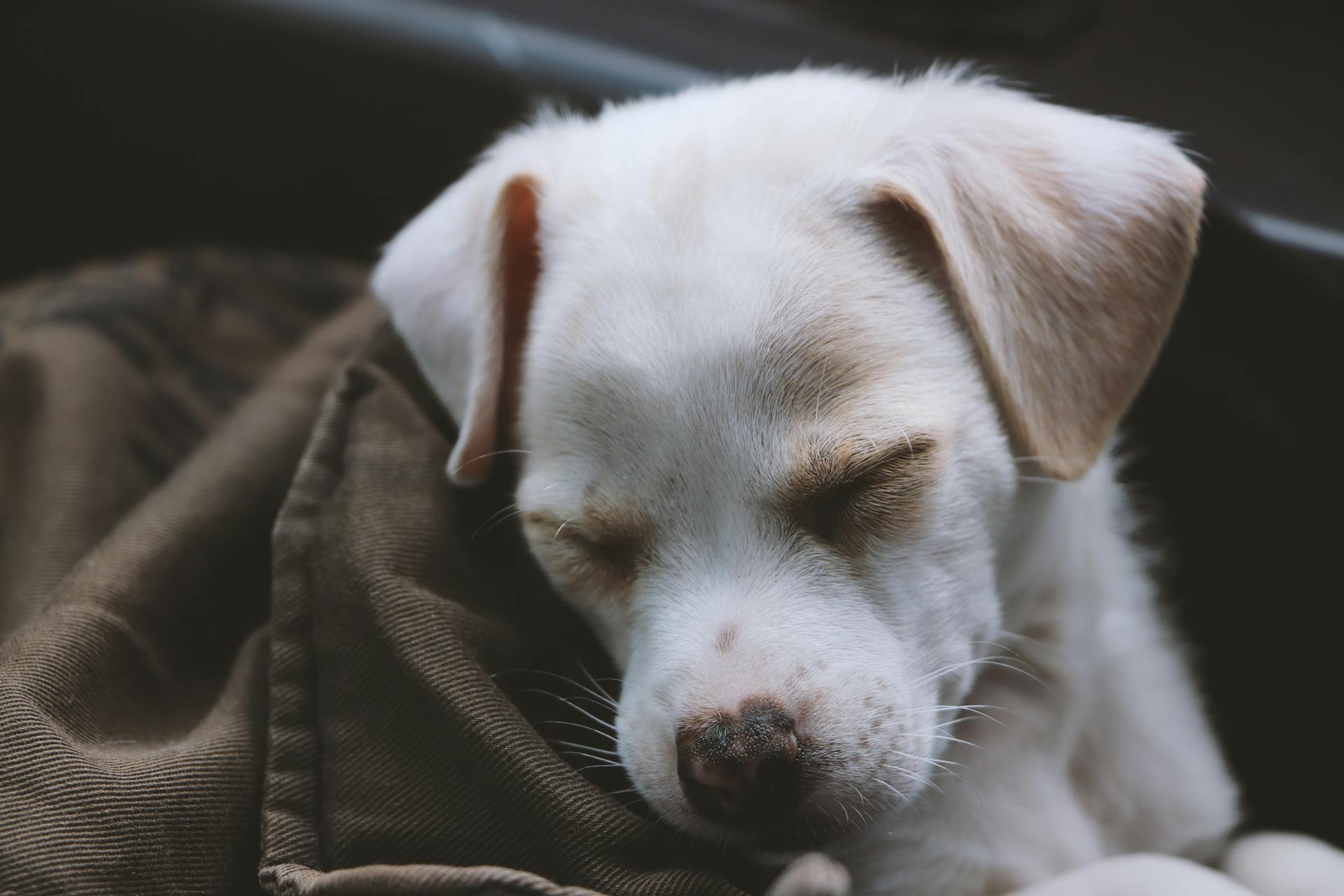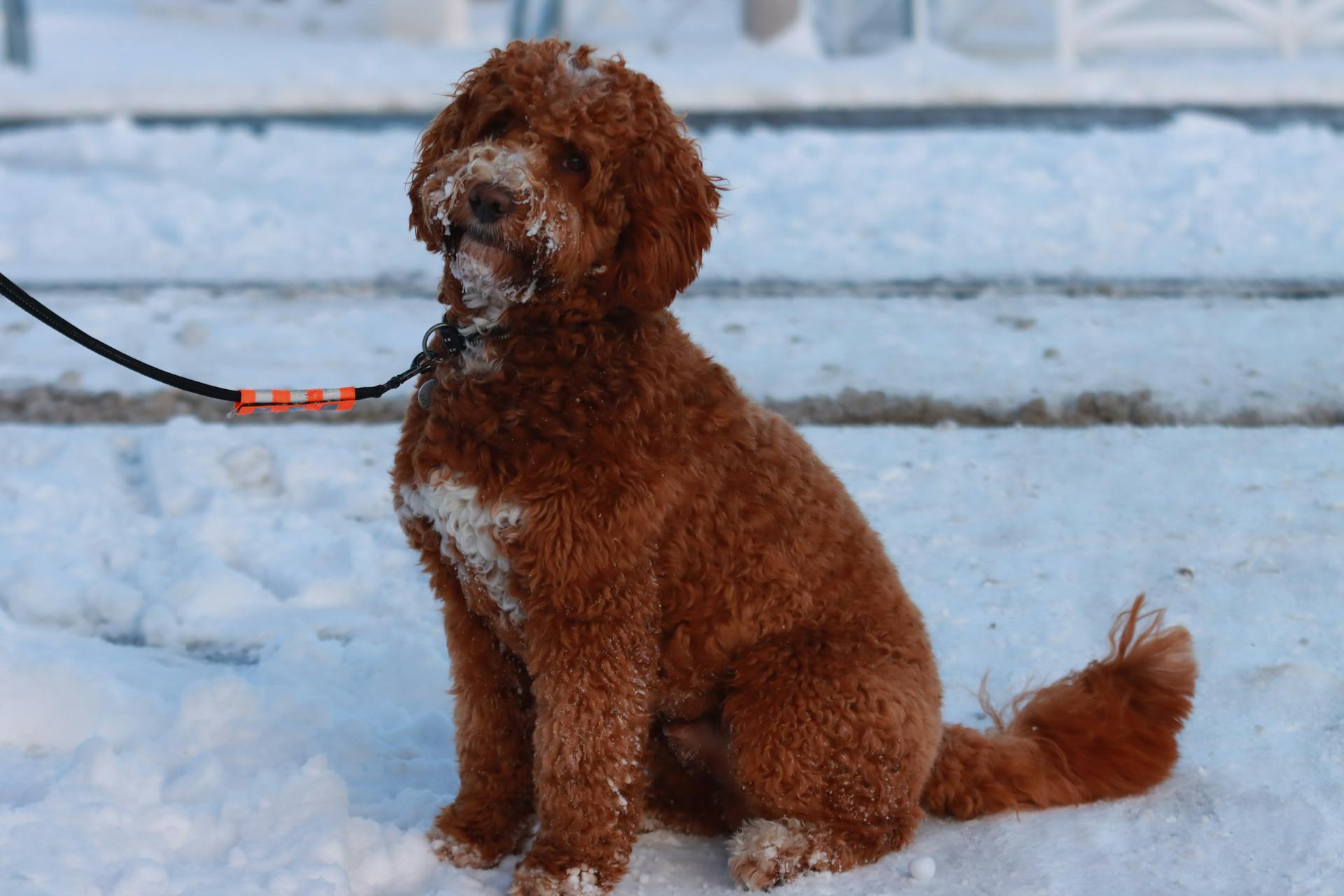
Labrador Retrievers are a popular breed, and for good reason - they're one of the most friendly and outgoing breeds around.
Their origins date back to the 18th century in Newfoundland, Canada, where they were bred to assist fishermen.
Labradors are naturally excellent swimmers, thanks to their water-resistant coat and webbed feet.
They were originally called St. John's Dogs, named after the city of St. John's in Newfoundland.
Labradors are highly intelligent, ranking 7th in Stanley Coren's book "The Intelligence of Dogs", which means they're relatively easy to train.
Their short, dense coat requires minimal grooming, making them a great choice for busy owners.
Labradors are generally healthy, but like all breeds, they can be prone to certain health issues, such as hip dysplasia and eye problems.
Their average lifespan is around 10-12 years, which is relatively long for a medium-sized breed.
Consider reading: Dogs Newfoundland Breed
Labrador Retriever Basics
Labrador Retrievers are one of the most popular breeds for families, and it's easy to see why - they're known for their kind and outgoing temperament.
Their coats are short and shedding, but they're very dense, so regular grooming with a good brush is a must.
Labradors come in three main colors: black, chocolate/liver, and yellow, with yellows ranging from light cream to fox red.
One of the most distinctive features of Labradors is their "otter tail" - thick at the base and tapering towards the tip, with no feathering.
Labradors are highly intelligent and naturally trainable, making them a great breed for first-time dog owners.
They're also prone to joint problems and arthritis, so it's essential to provide them with an orthopaedic dog bed and consider joint supplements.
Their high energy levels mean they need plenty of socialisation and exercise, but they'll reward you with their affection and loyalty.
Labradors are voracious eaters and can easily become overweight, so it's crucial to monitor their food intake and provide regular exercise.
See what others are reading: How Much Exercise Do Labrador Retrievers Need
Health and Care
Labradors are generally a healthy breed, but like any dog, they can be prone to certain health issues. Obesity is a common problem in Labradors, so it's essential to feed them properly and give them plenty of exercise.
To prevent obesity, make sure to limit treats and keep an eye on their food intake. A study has shown that Labradors have a higher risk of developing obesity compared to other breeds.
Labradors also have a higher risk of developing hip dysplasia and osteoarthritis, especially in their elbows and hips. Regular veterinary visits can help identify these issues early on.
Here are some common health problems to look out for in Labradors:
- Obesity
- Nasal hyperkeratosis (dry, cracked, or crusty skin on the nose)
- Snow nose (a lighter-colored nose, often caused by seasonal changes or genetics)
- Hip dysplasia
- Osteoarthritis
Health Problems
Labradors are generally a healthy breed, but like any dog, they can be prone to certain health problems. Obesity is a common issue, so be sure to feed your Lab properly and give them plenty of exercise.
Labradors can also develop nasal hyperkeratosis, a condition where the skin on their nose becomes dry, cracked, or crusty. Your vet may recommend pet balms or other treatments to keep the area hydrated.
Some Labradors may experience a condition known as "snow nose", where their nose becomes lighter in color, often due to seasonal changes, age, or genetics.

Hip dysplasia is another potential issue, where the femur bone and hip bone socket don't align properly. This can be a problem for Labs, especially given their size.
Osteoarthritis is a condition where inflammation and degeneration occur in joints over time, and Labs are more likely to develop it than other breeds. Common areas affected include the elbow and hips.
Here are some of the health conditions that Labradors are more prone to:
- Obesity
- Nasal hyperkeratosis
- Snow nose
- Hip dysplasia
- Osteoarthritis
Caring for Labradors
Labradors are not high-maintenance dogs, but they still need regular grooming to stay clean and healthy. Daily brushing is not necessary, but their double coat sheds a lot, so you should prepare to bathe them at least a few times a month.
To keep your Lab's coat under control, brush it regularly to prevent shedding from taking over your house. Bathing them every other month will keep them clean, and trimming their nails once or twice a month will prevent painful breaks.
On a similar theme: Shiba Inu Coin 1 Cents
Brushing your Lab's teeth 2-3 times a week is essential for maintaining oral hygiene. Regularly checking their ears for odors and redness will also help prevent ear infections.
Here are some common health problems that Labradors are prone to:
- Obesity: Be careful not to overindulge your Lab with treats, as they can easily develop obesity.
- Nasal hyperkeratosis: This condition causes dry, cracked, or crusty skin on your dog's nose, and your vet may recommend pet balms or other treatments.
- Snow nose: A lighter-colored nose can be a sign of snow nose, which is more common in the winter but can also be caused by other seasonal changes, age, or genetics.
- Hip dysplasia: This condition can cause your Lab's femur bone and hip bone socket to not align properly, so it's essential to keep an eye out for it.
- Osteoarthritis: Labradors are more likely to develop osteoarthritis, which causes inflammation and degeneration in joints over time.
Remove
Removing obstacles is a big part of caring for your labrador retriever. A tax was charged for owning a dog in Newfoundland, and the fee was higher for females.
Government regulation in Newfoundland led to the labrador retriever being nearly extinct by the 1880s. This is why it's essential to understand local laws and regulations regarding pet ownership.
Labradors were considered "expendable equipment" by the US military during the Vietnam war. This harsh reality highlights the importance of treating all living beings with respect and care.
Today, retired war dogs of the US military can return home and be adopted by civilian families, thanks to a bill signed by President Bill Clinton in 2000.
You might enjoy: German Military Dogs
Physical Attributes
Labrador Retrievers are a medium-sized breed, with a broad head and medium-sized eyes set relatively far apart. Their eyes are typically brown with black eye rims, although chocolate Labradors may have brown or hazel eyes with brown eye rims.
Labradors have a distinctive "otter tail" that's thick at the bottom and gradually thins towards the tip. Their ears are also quite notable, hanging close to their heads.
Labradors are built for swimming, with webbed feet that help them move through the water with ease. This makes them natural-born swimmers.
Here's a breakdown of the average height of a Labrador Retriever:
History and Origin
The Labrador retriever has a rich history that spans centuries. They originated from the island of Newfoundland, off the eastern coast of Canada.
In the early 1800s, Englishmen visiting the area took notice of the waterdogs, also known as St. John's water dogs or St. John's retrievers. These dogs were later brought back to England.
The Labrador retriever became officially recognized by The Kennel Club in England in 1903. By 1991, they had become the most-registered breed with the American Kennel Club, a title they've held for the last 30 years.
Take a look at this: Boston Terrier New England
History of the

The Labrador retriever's history is a fascinating one, and it all begins on the island of Newfoundland, off the eastern coast of Canada.
In the early 1800s, Englishmen visiting the area noticed the waterdogs, which would later become the foundation of the Labrador retriever breed.
These waterdogs are believed to be descendants of the St. John's water dog or St. John's retriever, a smaller version of the now-extinct larger St. John's Dogs.
The British standardized the breed over time, and by the 1900s, the Labrador retriever was well-known.
The Labrador retriever became officially recognized by The Kennel Club in England in 1903.
In 1917, the American Kennel Club registered the first Labrador retriever in the United States.
By 1991, Labrador retrievers had become the most-registered breed with the American Kennel Club, a title they've held for the last 30 years.
Check this out: St Bernese Mountain Dog Puppy
Hunting Dogs
Labradors are a popular choice for hunting due to their water-resistant fur, which keeps them warm in cold climates. Their energy and enthusiasm make them well-suited for chasing down small game.
One of the reasons Labradors excel as hunting dogs is that they're relatively easy to train. Their high energy levels also mean they'll stay engaged throughout a long hunt.
Their incredible water-resistant fur helps them stay warm during a cold duck hunt in northern climates.
Expand your knowledge: How Cold Is Too Cold for Labradors
Frequently Asked Questions
What do Labradors love the most?
Labradors love spending time with their owners and receiving extra attention. They also enjoy playing games and having something to chew on.
Are chocolate labs smart?
Yes, Chocolate Labs are highly intelligent dogs known for their trainability. Their high intelligence makes them a popular choice for various roles, including search and rescue and therapy work.
How long do chocolate labs live?
Chocolate Labradors typically live for around 10.7 years, which is 1.4 years shorter than their black or yellow counterparts. This lifespan difference is based on the largest UK study of the breed.
What are some fun facts about chocolate labs?
Chocolate Labs have a unique history, being close to extinction before gaining popularity, and are also known for their exceptional water resistance and search and rescue skills
What two dogs make a chocolate lab?
To produce a chocolate lab, both parents must be chocolate (bb) and contribute a chocolate allele. This ensures the puppy inherits two chocolate genes, one from each parent
Sources
- https://betterpet.com/labrador-retriever/
- https://urbananimal.co.in/labrador-retriever/
- https://www.horseandhound.co.uk/dogs/labrador-retriever-dog-breed-852244
- https://wagwalking.com/daily/8-incredible-facts-labrador-retrievers
- https://www.barkblaster.com/blog/labrador-retrievers-characteristics-facts-information-lab
Featured Images: pexels.com


